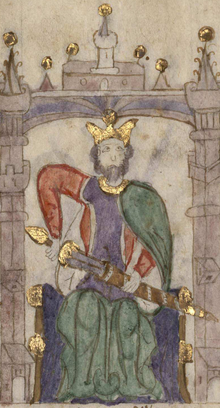Sancho II (Castile)
Sancho II (* around 1038; † October 7, 1072 ) was King of Castile from 1065 until his death and, for a short time, also King of León and Galicia in 1072 .
Life
Sancho was a son of King Ferdinand I of León and the Sancha of León . His siblings were:
- Urraca (* before 1037, † 1103), "Queen" of Zamora
- Alfonso VI (1037–1109), King of León and from 1072 also King of Castile and Galicia
- Elvira († 1099), mistress of Toro
- García (1042-1090), King of Galicia
Sancho was ordered to Saragossa by his father in 1063 to support the Moorish ruler there in the fight against King Ramiro I of Aragon , who was killed in the Battle of Graus . Sancho was the father's eldest son, but is said to have lagged behind in his fatherly affection for the younger Alfons, which is why the latter also received the much larger inheritance from his mother, the kingdom of León , when the paternal inheritance was made. Sancho, on the other hand, got the comparatively smaller county of Castile, for which he was endowed with all the regalia of a king. In 1068 he faced kings Sancho IV of Navarre and Sancho Ramírez of Aragón in the "War of the Three Sanchos" and was able to conquer Álava .
There has always been a subliminal enmity between Sancho and his siblings, which escalated into an open power struggle over the entire inheritance after the mother's death in 1067. In 1072, Sancho went on the offensive against the youngest brother García and drove him out of his kingdom of Galicia . The document system in Santiago de Compostela suggests that this strike was still carried out as a joint action with Alfons, but in the first days of January 1072 the militarily stronger Sancho also defeated Alfons in the battle of Golpejera and forced him to go into exile. On January 12th, Sancho was crowned king in León . So he seemed to emerge victorious from the power struggle, only his sister Urraca , who had stood by Alfons, still offered him resistance in her city of Zamora . During the siege of the city, Sancho was killed by a knight from Zamora, according to legend, Vellido Dolfos ; the act is said to have occurred after treason. So Alfons VI finally went. emerged victorious from the power struggle and united the legacy of his parents under his rule.
Sancho was buried in the Abbey of San Salvador de Oña . In the epitaph of his grave, his sister Urraca was identified as the main responsible for his death.
Sancho was married to a woman named Alberta who is only known in two documents from 1071. There is only a little credible account of her origin from the Chronica Naierensis , written in the 12th century , according to which she was a daughter of King García III. from Navarre and raped by her half-brother Sancho . And because he sought refuge with Ramiro I of Aragón, the fateful battle of Graus occurred. Modern Spanish historians suspect William the Conqueror to be the father of Alberta, although he did not have a known daughter of that name.
One of Sancho's closest confidants was the Castilian nobleman Rodrigo Díaz de Vivar, who was to go down in Spanish folklore as " El Cid " .
literature
- Susan Havens Caldwell: Urraca of Zamora and San Isidoro in León: Fulfillment of a Legacy. In: Woman's Art Journal. Vol. 7 (1986), pp. 19-25.
- Bernard F. Reilly: The Kingdom of León-Castilla under King Alfonso VI 1065-1109. Princeton University Press, 1988 ( online ).
Individual evidence
- ↑ Historia Silense, ed. by Simon Barton and Richard Fletcher, in: The World of El Cid: Chronicles of the Spanish Reconquest. Manchester University Press, 2000, §81, p. 45. Crónica del Obispo Don Pelayo, ed. by Benito Sánchez Alonso (1924), p. 73.
- ↑ Crónica del Obispo Don Pelayo, ed. by Benito Sánchez Alonso (1924), p. 78.
- ↑ Historia Silense , ed. by Simon Barton and Richard Fletcher, in: The World of El Cid: Chronicles of the Spanish Reconquest. Manchester University Press, 2000, §10, pp. 31-32. Chronicon Regum Legionensium, ed. by Simon Barton and Richard Fletcher, in: The World of El Cid: Chronicles of the Spanish Reconquest. Manchester University Press, 2000, p. 84.
- ↑ Chronicon Regum Legionensium, ed. by Simon Barton and Richard Fletcher, in: The World of El Cid: Chronicles of the Spanish Reconquest. Manchester University Press, 2000, p. 84.
- ↑ See Caldwell, p. 21, note 23.
- ↑ Crónica Najerense, ed. by Antonio Ubieto Arteta (1966), p. 110.
- ↑ Felipe R. Cordero Carrete: De los esponsales de una hija de Guillermo el Conquistador con un rey de Galicia. In: Cudernos de estudios gallegos. Vol. 7 (1952), pp. 55-78.
| predecessor | Office | successor |
|---|---|---|
| Ferdinand I. |
King of Castile 1065-1072 |
Alfonso VI |
| García |
King of Galicia 1072 |
Alfonso VI |
| Alfonso VI |
King of León 1072 |
Alfonso VI |
| personal data | |
|---|---|
| SURNAME | Sancho II. |
| BRIEF DESCRIPTION | King of Castile, León and Galicia |
| DATE OF BIRTH | around 1038 |
| DATE OF DEATH | October 7, 1072 |

